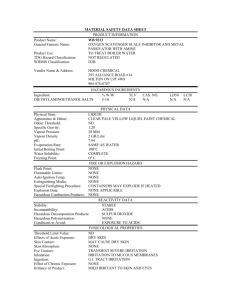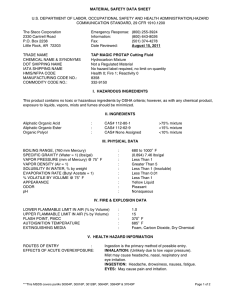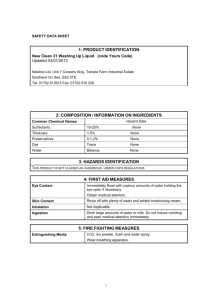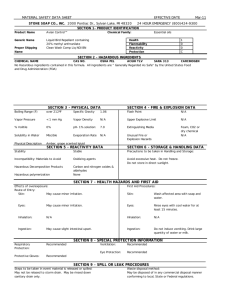MSDS - ABS General Purpose
advertisement
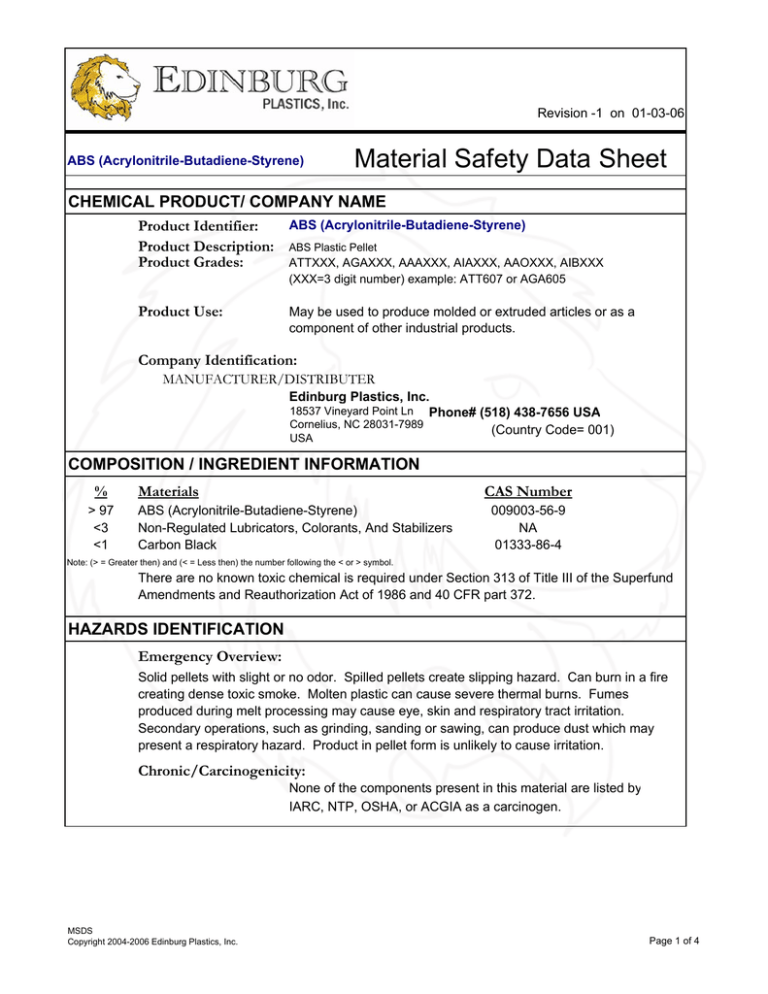
Revision -1 on 01-03-06 ABS (Acrylonitrile-Butadiene-Styrene) Material Safety Data Sheet CHEMICAL PRODUCT/ COMPANY NAME ABS (Acrylonitrile-Butadiene-Styrene) Product Identifier: Product Description: ABS Plastic Pellet Product Grades: ATTXXX, AGAXXX, AAAXXX, AIAXXX, AAOXXX, AIBXXX (XXX=3 digit number) example: ATT607 or AGA605 Product Use: May be used to produce molded or extruded articles or as a component of other industrial products. Company Identification: MANUFACTURER/DISTRIBUTER Edinburg Plastics, Inc. 18537 Vineyard Point 135 Rosemont St Ln Phone# (518) 438-7656 USA Cornelius, NC 28031-7989 Albany, NY 12203-2422 USA (Country Code= 001) USA COMPOSITION / INGREDIENT INFORMATION % > 97 <3 <1 Materials CAS Number ABS (Acrylonitrile-Butadiene-Styrene) Non-Regulated Lubricators, Colorants, And Stabilizers Carbon Black 009003-56-9 NA 01333-86-4 Note: (> = Greater then) and (< = Less then) the number following the < or > symbol. There are no known toxic chemical is required under Section 313 of Title III of the Superfund Amendments and Reauthorization Act of 1986 and 40 CFR part 372. HAZARDS IDENTIFICATION Emergency Overview: Solid pellets with slight or no odor. Spilled pellets create slipping hazard. Can burn in a fire creating dense toxic smoke. Molten plastic can cause severe thermal burns. Fumes produced during melt processing may cause eye, skin and respiratory tract irritation. Secondary operations, such as grinding, sanding or sawing, can produce dust which may present a respiratory hazard. Product in pellet form is unlikely to cause irritation. Chronic/Carcinogenicity: None of the components present in this material are listed by IARC, NTP, OSHA, or ACGIA as a carcinogen. MSDS Copyright 2004-2006 Edinburg Plastics, Inc. Page 1 of 4 Melt Processing Health Effects: Molten plastic can cause severe burns. Processing fumes may cause irritation to the eyes, skin and respiratory tract, and in cases of severe overexposure, nausea and headache. Medical Restrictions: There are no known human health effects aggravated by exposure to this product. However, certain sensitive individuals and individuals with respiratory impairments may be affected by exposure to components in the processing fumes. FIRST AID MEASURES Eyes: Immediately flush eyes with plenty of water for at least 15 minutes. Call a physician. Skin: The compound is not likely to be hazardous by skin contact, but cleansing the skin after use is advisable. If molten polymer gets on skin, cool rapidly with cold water. do not attempt to peel polymer from skin. Obtain medical treatment for thermal burn. Ingestion: No specific intervention is indicated as compound is not likely to be hazardous by ingestion. Consult a physician if necessary Inhalation: No specific intervention is indicated as the compound is not likely to be hazardous by inhalation. Consult a physician if necessary. If exposed to fumes from overheating or combustion, move to fresh air. Consult a physician if symptoms persist. For processing fume inhalation irritation, leave contaminated area and breathe fresh air. If coughing, difficult breathing or any other symptoms develop, seek medical attention at once, even if symptoms develop at a later time. For skin contact with fume condensate, immediately wash thoroughly with soap and water. If irritation develops, seek medical attention. FIRE FIGHTING MEASURES Fire Fighting: Keep personnel removed and upwind of fire. Wear self-contained breathing apparatus and protective fire fighting clothing. Extinguishing Media: Water (mist or light spray at first), Foam, Dry Chemical, CO2 Hazardous Combustion Products: Hazardous gases/vapors produced in fire are: Phenolic compounds, nitrogen oxide, hydrogen bromide, carbon monoxide; small amounts of hydrogen cyanide and styrene. Flash Point: > 404ºC (759ºF) Estimated Auto-ignition Temperature: > 466ºC (871ºF) Estimated ACCIDENTAL RELEASE MEASURES General: MSDS Copyright 2004-2006 Edinburg Plastics, Inc. Review FIRE FIGHTING MEASURES and HANDLING Sections. Page 2 of 4 HANDLING AND STORAGE Handling: See FIRST AID and PERSONAL PROTECTIVE EQUIPMENT SECTIONS. Store in a cool, dry place. Keep containers tightly closed to prevent moisture absorption and contamination. Storage: EXPOSURE CONTROLS/PERSONAL PROTECTION Engineering Controls: Use local ventilation to control fumes from hot processing. Personal Protection: Eye/Face: Skin: Respiratory: Wear safety glasses. Wear coverall chemical splash goggles and face shield when possibility exists for eye and face contact due to splashing or spraying of molten material. A full face mask respirator provides protection from eye irritation. If there is potential contact with hot/molten material, wear heat resistant clothing and footwear. A NIOSH/MSHA approved air purifying respirator with an organic vapor cartridge with a dust/mist filter may be permissible under certain circumstances where airborne concentrations are expected to exceed exposure limits. Protection provided by air purifying respirator if there is any potential for an uncontrolled release, exposure levels are not known, or any other circumstances where air purifying respirators may not provide adequate protection. PHYSICAL AND CHEMICAL PROPERTIES Physical State: Solid Odor: Possibly a slight organic odor Melting Point: >100ºC (212ºF) Specific Gravity (water=1): >1.02 Water Solubility: Insoluble %Volatiles: Not Determined STABILITY AND REACTIVITY Stability: Polymerization: Conditions To Avoid: Incompatabilities: Hazardous Decomposition: Stable Polymerization will not occur Expoxure to open flame or temperatures >530ºF for pro-longed time. Other Materials Hazardous gases or vapors can be released, including Phenolic compounds, nitrogen oxide, hydrogen bromide, carbon monoxide; small amounts of hydrogen cyanide and styrene. MSDS Copyright 2004-2006 Edinburg Plastics, Inc. Page 3 of 4 ECOLOGICAL INFORMATION AQUATIC TOXICITY: No information is available. Toxicity is expected to be low based on insolubility in water. DISPOSAL INFORMATION Waste Disposal: Preferred options for disposal are (1) recycling, (2) incineration with energy recovery, and (3) landfill. The high fuel value of this product makes option 2 very desirable for material that cannot be recycled, but incinerator must be capable of scrubbing out acidic combustion products. Treatment, storage, transportation, and disposal must be in accordance with applicable federal, state/provincial, and local regulations. TRANSPORTATION INFORMATION DOT Hazard Class: Not Regulated Proper Shipping Name: Not Regulated Identification Number: Not Listed REGULATORY INFORMATION TSCA Status: In compliance with TSCA Inventory requirements for commercial purposes. WHMIS Classification:Not a controlled product. This product does not contain reportable quantities of substances subject to supplier notification. OTHER Medical Use: ` User Responsibility: MSDS Copyright 2004-2006 Edinburg Plastics, Inc. CAUTION: Do not use in medical applications involving permanent implantation in the human body. Each user should read and understand this information and incorporate it into individual site safety programs in accordance with applicable hazard communication standards and regulations. Page 4 of 4
